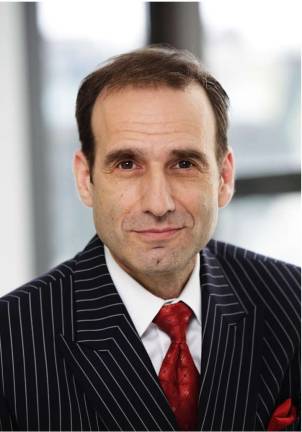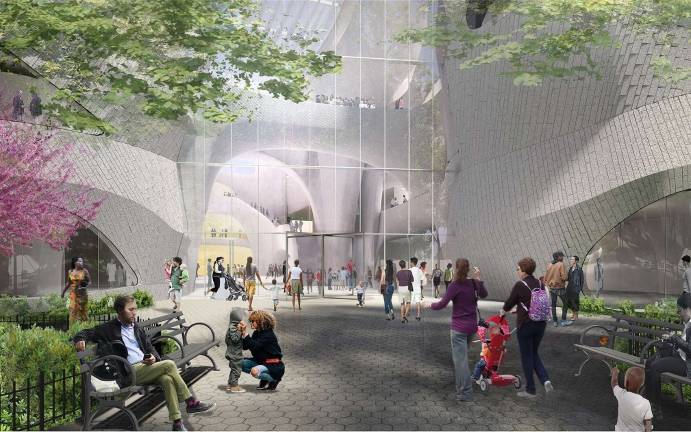The Preservation Lawyer


Land-use and preservation cases didn’t always dominate Michael Hiller’s caseload. For much of his career, they didn’t make up the lions’ share of the work taken on by his Manhattan-based law firm. As he tells it, the focus of his practice began to shift not because he changed, but because municipal politics did. The number of land-use and preservation cases grew under the Michael Bloomberg administration, he said, but truly exploded when Bill de Blasio took office in 2013.
“This is the most development-friendly mayoral administration in the history of the city,” Hiller said.
In recent years, community groups have enlisted Hiller in a number of notable preservation and land-use cases, including efforts to block the construction condos at a former Underground Railroad site in Chelsea and the former First Church of Christ, Scientist on Central Park West, remove historic stacks of books from the New York Public Library, and oppose the America Museum of Natural History’s controversial Gilder Center expansion plan.
The Gilder Center proposal, currently in the city’s environmental review process, calls for the construction of a new museum building that would occupy a portion of Theodore Roosevelt Park. One local group opposing the plan, Community United to Protect Theodore Roosevelt Park, enlisted Hiller to help in their fight. “It was very clear that hiring Michael Hiller was the only possible way forward,” said Bill Raudenbush, a member of Community United to Protect Theodore Roosevelt Park who is now running for City Council on the Upper West Side. “He is hands-down the best land-use attorney and the best voice about developers and development that this city has,” Raudenbush said. “Thank God he’s on our side.”
According to Hiller, the Gilder Center plan would amount to an illegal expansion. “What they would be doing is expanding into the grassy green areas of the park that don’t belong to the museum,” he said. “That land belongs to the city and to the people. If the city wants to cede that land to the museum, they have to go through the ULURP process,” the city’s land-use review procedure.
“I love the American Museum of Natural History,” Hiller added. “It’s a great place. I’ve been there many times and my kids love it. But the notion that an institution is going to be taking away a public resource — specifically public greenspace — for really no reason at all doesn’t make a lot of sense to me.”
As a characteristic example of recent development projects he considers irresponsible, Hiller points to 432 Park Ave., the tallest residential tower in the city (soon to be surpassed by the Central Park Tower, under construction nearby on 57th Street), visible from the windows of his Madison Avenue law offices. The tower’s design features two-floor-tall spaces placed at regular intervals up the nearly 1,400-foot-tall structure. The building’s mechanical core runs through the openings, but they are otherwise empty. Popular wisdom at street-level often holds that the gaps are intended to let wind pass through the building’s slender frame. But according to Hiller, the empty spaces — known as mechanical voids in technical parlance — are actually a subtle means by which developers have begun exploiting a zoning loophole to let them build higher. Height limits in the area are based on buildings’ floor area, but because mechanical spaces don’t count toward that total, they can be used like stilts to boost the height — and value — of a tower’s top floors.
“It has nothing to do with wind,” Hiller said. “Mechanical voids are often added because developers want to artificially increase the height of the building by eliminating the bulk on those lower floors so they can raise the overall height of the buildings without offending the zoning resolution.”
The use of mechanical voids and other tactics for building taller, such as putting higher ceilings on each floor increase overall height, has grown more common in recent years. Developers have been emboldened, Hiller says, by city agencies that have often acted as enablers. “This mayoral administration hands out approvals to developers like hot dogs at the Garden,” he said.
One of Hiller’s recent preservation victories ended with the reversal a city-approved plan to convert a landmarked space to a private residence in the Clock Tower Building at 346 Broadway in lower Manhattan. The upper floors that hold the building’s eponymous clock had been designated an interior landmark in 1987 — due in part to the clock’s unique mechanism, which must be wound by hand and is one of the last of its kind still in operation — but in 2013 the city’s Landmarks Preservation Commission issued a certificate of appropriateness to convert the space to a luxury condominium and electrify the clock’s mechanism. Hiller, representing preservation groups, sued the city and developer and won a ruling in the State Supreme Court last year that reversed the landmarks commission’s decision. “They would have privatized an interior landmark and excluded the public from it, something that has never happened in the history of the landmarks law,” he said.
The case illustrated a dynamic that is not uncommon — financial ties between the mayor and developers with business before the city, which, even if nothing inappropriate has taken place, can create the appearance of impropriety. One of the project’s developer, Don Peebles, had previously contributed (and was later refunded) $20,000 to de Blasio’s Campaign for One New York nonprofit, which was later disbanded in the wake of a federal investigation into whether donors to the fund received favorable treatment from City Hall in exchange for contributions (no charges were filed).
Lawsuits that challenge rulings of city agencies are difficult to win because the standard of review is deferential to the agency that made the determination. Hiller argues that standard is in need of adjustment. “If an applicant or developer has given money to the mayor’s office or to a lobbyist who has contributed to the mayor’s office, there should be no deferential standard,” he said.
Hiller says he would be happy to devote more of his time and attention to cases in other practice areas, but for the time being, he feels the issues at hand in the city’s ongoing land-use and preservation battles are simply too important to neglect. “When city government makes a conscious decision to sacrifice the diversity in architecture and planning — when the city decides to cede parkland and landmark buildings and historic districts to wealthy developers who just happen to have donated money to the mayor and his pet projects — New York City loses part of its identity,” Hiller said.
“As we lose the soul of the city in its architecture, its landmark buildings and historic districts, and its urban planning, we lose our identity as people,” he continued. “I think that is the greatest threat to New York City. It’s not only the violations of the zoning resolution, it’s not only the way it’s bent into a pretzel to accommodate the aspirations of developers, it’s not only the graft and the appearance of corruption. It’s that the City of New York is fundamentally losing in its character. And one day, we’re going to wake up one day and find we’re living in a very different place.”